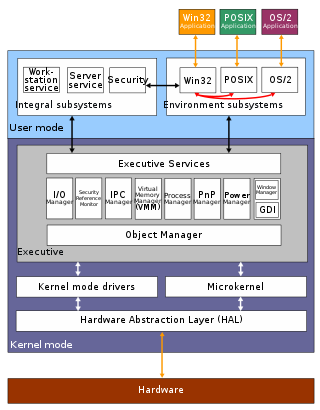Active Directory (AD) is a directory service developed by Microsoft for Windows domain networks. Windows Server operating systems include it as a set of processes and services. Originally, only centralized domain management used Active Directory. However, it ultimately became an umbrella title for various directory-based identity-related services.
In telecommunications, provisioning involves the process of preparing and equipping a network to allow it to provide new services to its users. In National Security/Emergency Preparedness telecommunications services, "provisioning" equates to "initiation" and includes altering the state of an existing priority service or capability.
Simple Network Management Protocol (SNMP) is an Internet Standard protocol for collecting and organizing information about managed devices on IP networks and for modifying that information to change device behavior. Devices that typically support SNMP include cable modems, routers, network switches, servers, workstations, printers, and more.

The Graphics Device Interface (GDI) is a legacy component of Microsoft Windows responsible for representing graphical objects and transmitting them to output devices such as monitors and printers. It was superseded by DirectDraw API and later Direct2D API. Windows apps use Windows API to interact with GDI, for such tasks as drawing lines and curves, rendering fonts, and handling palettes. The Windows USER subsystem uses GDI to render such UI elements as window frames and menus. Other systems have components that are similar to GDI; for example: Mac OS had QuickDraw, and Linux and Unix have X Window System core protocol.
In computing, a directory service or name service maps the names of network resources to their respective network addresses. It is a shared information infrastructure for locating, managing, administering and organizing everyday items and network resources, which can include volumes, folders, files, printers, users, groups, devices, telephone numbers and other objects. A directory service is a critical component of a network operating system. A directory server or name server is a server which provides such a service. Each resource on the network is considered an object by the directory server. Information about a particular resource is stored as a collection of attributes associated with that resource or object.

CUPS is a modular printing system for Unix-like computer operating systems which allows a computer to act as a print server. A computer running CUPS is a host that can accept print jobs from client computers, process them, and send them to the appropriate printer.
The Service Location Protocol is a service discovery protocol that allows computers and other devices to find services in a local area network without prior configuration. SLP has been designed to scale from small, unmanaged networks to large enterprise networks. It has been defined in RFC 2608 and RFC 3224 as standards track document.
In computer networks, a network element is a manageable logical entity uniting one or more physical devices. This allows distributed devices to be managed in a unified way using one management system.
The Common Management Information Protocol (CMIP) is the OSI specified network management protocol.
Element management is concerned with managing network elements on the network element management layer (NEL) of the TMN . An element management system (EMS) manages one or more of a specific type of telecommunications network elements (NE).

A barcode printer is a computer peripheral for printing barcode labels or tags that can be attached to, or printed directly on, physical objects. Barcode printers are commonly used to label cartons before shipment, or to label retail items with UPCs or EANs.
In computing, a system resource, or simply resource, is any physical or virtual component of limited availability that is accessible to a computer. All connected devices and internal system components are resources. Virtual system resources include files, network connections, and memory areas.
Advanced Function Presentation (AFP) is a presentation architecture and family of associated printer software and hardware that provides for document and information presentation independent of specific applications and devices.

The architecture of Windows NT, a line of operating systems produced and sold by Microsoft, is a layered design that consists of two main components, user mode and kernel mode. It is a preemptive, reentrant multitasking operating system, which has been designed to work with uniprocessor and symmetrical multiprocessor (SMP)-based computers. To process input/output (I/O) requests, it uses packet-driven I/O, which utilizes I/O request packets (IRPs) and asynchronous I/O. Starting with Windows XP, Microsoft began making 64-bit versions of Windows available; before this, there were only 32-bit versions of these operating systems.
In computing, a shared resource, or network share, is a computer resource made available from one host to other hosts on a computer network. It is a device or piece of information on a computer that can be remotely accessed from another computer transparently as if it were a resource in the local machine. Network sharing is made possible by inter-process communication over the network.
Windows Vista contains a range of new technologies and features that are intended to help network administrators and power users better manage their systems. Notable changes include a complete replacement of both the Windows Setup and the Windows startup processes, completely rewritten deployment mechanisms, new diagnostic and health monitoring tools such as random access memory diagnostic program, support for per-application Remote Desktop sessions, a completely new Task Scheduler, and a range of new Group Policy settings covering many of the features new to Windows Vista. Subsystem for UNIX Applications, which provides a POSIX-compatible environment is also introduced.
CEN ISO/IEEE 11073 Health informatics - Medical / health device communication standards enable communication between medical, health care and wellness devices and external computer systems. They provide automatic and detailed electronic data capture of client-related and vital signs information, and of device operational data.
An element management system (EMS) consists of systems and applications for managing network elements (NE) on the network element-management layer (NEL) of the Telecommunications Management Network (TMN) model.
HP Universal Print Driver (UPD) is an intelligent print driver that supports a broad range of HP print devices, such as LaserJet and various MFPs. Developed by Hewlett-Packard, HP UPD combines a general purpose driver (XPSDrv, UniDrv, or PSCRIPT), print control, and HP proprietary extensions. The HP UPD simplifies driver deployment and management across multiple devices and networks via a unified program. This advanced print driver has the ability to discover HP print devices and automatically expose the client to device capabilities (e.g., duplex, color, finishing, etc.).
There are, in essence, three kinds of Cloud printing.


